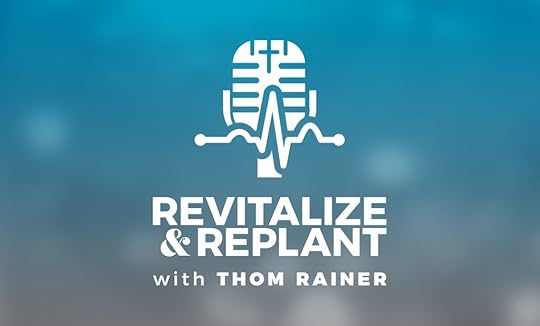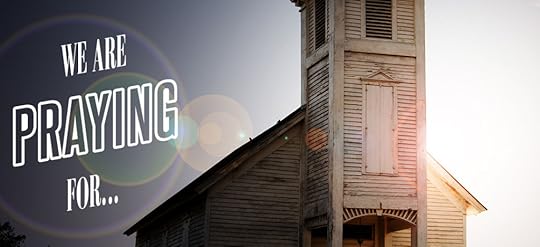Thom S. Rainer's Blog, page 87
May 8, 2020
Happy Mother’s Day with the Rainer Wives

Podcast Episode #639
SUBSCRIBE:
iTunes • RSS • Stitcher • TuneIn Radio • Google Play • iHeart Radio • Spotify
We are incredibly thankful for the mothers in all our lives and are excited to celebrate the mothers in our lives. This very special episode of Rainer on Leadership features the wisdom and grace of the Rainer wives.
Resources mentioned in today’s podcast:
Church Future Indicator
Episode Sponsors
 The mission at Southeastern Baptist Theological Seminary is to glorify the Lord Jesus Christ by equipping students to serve the church and fulfill the Great Commission. The school offers more than 40 different degree programs, including the new Master of Arts in Church Revitalization in partnership with Church Answers and the Revitalization Network. This 37-hour degree is designed to help students move established churches from flatlining to flourishing.
The mission at Southeastern Baptist Theological Seminary is to glorify the Lord Jesus Christ by equipping students to serve the church and fulfill the Great Commission. The school offers more than 40 different degree programs, including the new Master of Arts in Church Revitalization in partnership with Church Answers and the Revitalization Network. This 37-hour degree is designed to help students move established churches from flatlining to flourishing.
Learn about this program and more by visiting sebts.edu. Where are you going? Southeastern will help you get there.
Feedback
If you have a question you would like answered on the show, fill out the form on the podcast page here at ThomRainer.com. If we use your question, you’ll receive a free copy of Scrappy Church.
May 7, 2020
Pastoring a Four Member Church in the Post-Pandemic Era

SUBSCRIBE TODAY:
iTunes • RSS • Stitcher • TuneIn Radio • Google Play • Spotify
During this time as we look toward the post-pandemic era, an interesting development has occurred in the life of our friend, Mark Clifton. He is currently being considered as pastor of a 3-member church. Listen in as he shares his unique strategy as he steps into this new opportunity.
Mark’s story
Understanding the hope every church has
Why the church facility is important
The abundance of adoption/replanting opportunities today
Resources mentioned in today’s podcast:
North American Mission Board

Revitalize & Replant is sponsored by the North American Mission Board and ChurchReplanters.com. More than 10% of churches in North America are at risk of closing and the North American Mission Board is committed to reversing this trend by decreasing the death rate of existing churches while simultaneously increasing the birth rate of new churches. To learn more about what it means to become a replanting pastor or to explore resources for replanting and revitalization in your own church, visit ChurchReplanters.com.
Submit Your Question:
Do you have a question about church revitalization or replanting for us to use on the podcast? Visit the podcast page to submit your question. If we use it on the show, you’ll get a copy of Autopsy of a Deceased Church and Reclaiming Glory.
May 6, 2020
The Difference between Confidence and Arrogance

By Sam Rainer
We ask leaders to be confident, but we bristle when they become arrogant. What is the difference? The dictionary reveals arrogance is pride, egotism, and inflated self-importance, while confidence is the state of being certain. When an arrogant person grates you, however, you’re not thinking about the technical nuances between confidence and arrogance. You simply feel it.
Pastors should preach boldly and lead confidently. The foundation of Scripture gives this assurance. But when church leaders begin to rely on their own abilities, arrogance builds, especially when the church grows. Arrogance is the catalyst for building your own kingdom instead of God’s kingdom. How can you tell when confidence is slipping into arrogance?
Constant defensiveness. Every leader has moments of defensiveness. After all, leaders receive more attention—and thus more blame—for the decisions they make. Rightly so. But when the default reaction to criticism becomes defensiveness, there is reason for concern. Constant defensiveness is a sign the church leader is relying on himself or herself too much. And self-reliance is one of the pillars of arrogance.
Protectionism. When ministries become “my turf,” arrogant decisions become normative. Church leaders should do everything they can to prop up their ministries. However, when church leaders advance their ministries at the expense of others, it’s a sign confidence has become arrogance. Church ministry is not a zero sum game, in which a gain in one area comes at the expense of another area. Good ministry, and confident leaders, are collaborative and cooperative.
Imitation. Imitating other mature leaders is biblical, if the goal of this imitation is to be like Christ. Imitating others to mirror their success is arrogance. Frequently comparing yourself to other successful church leaders is a form of ministry envy.
Using intellect as a weapon. One of the greatest pieces of advice I’ve ever received came from a quiet—but godly—personnel committee member: “Sam, it’s good you like to learn, but don’t ever use your intellect as a weapon.” Those words have stuck with me. Just because you might know a few more facts than the next person does not give you the right to use them to demean others. Only arrogant leaders use their intellect to climb over followers. Intellectual elitism has no place in the church.
Self-promotion. This one is obvious. If all your sermon examples are about you, then you’ve got a problem with arrogance. If all your tweets are about you, then you’ve got a problem with arrogance. The problem with arrogant self-promoters is they don’t recognize their problem. Thus the cycle of arrogance and self-promotion.
Boldness and confidence are biblical. Arrogance is destructive. Discerning the difference between confidence and arrogance can be difficult. Defensiveness, protectionism, imitation, intellectual elitism, and self-promotion are all major warning signs of arrogance.
May 5, 2020
The Difference between Confidence and Arrogance
By Sam Rainer
We ask leaders to be confident, but we bristle when they become arrogant. What is the difference? The dictionary reveals arrogance is pride, egotism, and inflated self-importance, while confidence is the state of being certain. When an arrogant person grates you, however, you’re not thinking about the technical nuances between confidence and arrogance. You simply feel it.
Pastors should preach boldly and lead confidently. The foundation of Scripture gives this assurance. But when church leaders begin to rely on their own abilities, arrogance builds, especially when the church grows. Arrogance is the catalyst for building your own kingdom instead of God’s kingdom. How can you tell when confidence is slipping into arrogance?
Constant defensiveness. Every leader has moments of defensiveness. After all, leaders receive more attention—and thus more blame—for the decisions they make. Rightly so. But when the default reaction to criticism becomes defensiveness, there is reason for concern. Constant defensiveness is a sign the church leader is relying on himself or herself too much. And self-reliance is one of the pillars of arrogance.
Protectionism. When ministries become “my turf,” arrogant decisions become normative. Church leaders should do everything they can to prop up their ministries. However, when church leaders advance their ministries at the expense of others, it’s a sign confidence has become arrogance. Church ministry is not a zero sum game, in which a gain in one area comes at the expense of another area. Good ministry, and confident leaders, are collaborative and cooperative.
Imitation. Imitating other mature leaders is biblical, if the goal of this imitation is to be like Christ. Imitating others to mirror their success is arrogance. Frequently comparing yourself to other successful church leaders is a form of ministry envy.
Using intellect as a weapon. One of the greatest pieces of advice I’ve ever received came from a quiet—but godly—personnel committee member: “Sam, it’s good you like to learn, but don’t ever use your intellect as a weapon.” Those words have stuck with me. Just because you might know a few more facts than the next person does not give you the right to use them to demean others. Only arrogant leaders use their intellect to climb over followers. Intellectual elitism has no place in the church.
Self-promotion. This one is obvious. If all your sermon examples are about you, then you’ve got a problem with arrogance. If all your tweets are about you, then you’ve got a problem with arrogance. The problem with arrogant self-promoters is they don’t recognize their problem. Thus the cycle of arrogance and self-promotion.
Boldness and confidence are biblical. Arrogance is destructive. Discerning the difference between confidence and arrogance can be difficult. Defensiveness, protectionism, imitation, intellectual elitism, and self-promotion are all major warning signs of arrogance.
The post The Difference between Confidence and Arrogance appeared first on Church Answers.
Seven Ways to Be A Better Servant Leader for Your Church

Podcast Episode #638
SUBSCRIBE:
iTunes • RSS • Stitcher • TuneIn Radio • Google Play • iHeart Radio • Spotify
Today’s leadership lesson handles the common topic of servant leadership but with a different perspective. These seven ways to be a better servant leader for your church will hit home for many listeners.
Take the initiative with hurting people.
Offer genuine apologies.
Do not speak ill of others publicly.
Seek out real accountability.
Give sacrificially to your church.
Be the first to give up your personal preferences.
Volunteer for menial tasks.
Resources mentioned in today’s podcast:
Church Future Indicator
Episode Sponsors
 The mission at Southeastern Baptist Theological Seminary is to glorify the Lord Jesus Christ by equipping students to serve the church and fulfill the Great Commission. The school offers more than 40 different degree programs, including the new Master of Arts in Church Revitalization in partnership with Church Answers and the Revitalization Network. This 37-hour degree is designed to help students move established churches from flatlining to flourishing.
The mission at Southeastern Baptist Theological Seminary is to glorify the Lord Jesus Christ by equipping students to serve the church and fulfill the Great Commission. The school offers more than 40 different degree programs, including the new Master of Arts in Church Revitalization in partnership with Church Answers and the Revitalization Network. This 37-hour degree is designed to help students move established churches from flatlining to flourishing.
Learn about this program and more by visiting sebts.edu. Where are you going? Southeastern will help you get there.
Feedback
If you have a question you would like answered on the show, fill out the form on the podcast page here at ThomRainer.com. If we use your question, you’ll receive a free copy of Scrappy Church.
May 4, 2020
Five Likely Consequences of the Pandemic Most Church Leaders Do Not Expect

By Thom S. Rainer
There have been volumes written about the church world in a post-pandemic era. There have been webinars and blogs and podcasts and more. Indeed, I am one of those who has joined the chorus of voices sharing my perspectives with local congregations.
I have also been looking below the surface to see what might transpire that might not be readily obvious. These five likely consequences range from the trivial to the important.
Many churches will always have one digital worship service available for emergencies. It is not unusual for a church to have one or more services a year that are canceled (or should be canceled) due to dangerous weather conditions. Since so many people have embraced streaming services, it will be easy to point them to a pre-recorded service if they can’t meet in person.
Worship wars will decrease significantly. Church members have been exposed to a wide variety of worship styles during the pandemic. They now have the realization that the world does not come to an end when the style is not exactly their preference. There will be a greater openness to these worship styles in their own congregations.
More churches will add automated door openers. Thanks to Tim Cool of Smart Church Solutions for making this observation in a podcast on Rainer on Leadership. People now prefer not to touch doors. These automatic openers are now affordable for most churches.
Fewer churches will have a person handing out bulletins/worship folders. That’s one more point of contact that can be avoided. Typically, there will be a sign that says something like, “Take One for the Worship Service.” Or there will be someone greeting people who points out the worship folders to those entering the worship center.
The newest financial metric will be percentage of digital and scheduled giving to total giving. There will even be metrics that suggest what a healthy percentage will be. Even now, I am suggesting churches have no less than 60% for the ratio, with a guidance to try to get the digital and scheduled giving to at least 80%. I am aware of a larger established church that moved this ratio from 20% to 70% during the pandemic. I am also aware of a three-year old church with a ratio of 98%.
There will likely be many more consequences of the pandemic we did not expect in our churches. I would love to hear from you about the changes you think will take place.
May 3, 2020
Five Likely Consequences of the Pandemic Most Church Leaders Do Not Expect
By Thom S. Rainer
There have been volumes written about the church world in a post-pandemic era. There have been webinars and blogs and podcasts and more. Indeed, I am one of those who has joined the chorus of voices sharing my perspectives with local congregations.
I have also been looking below the surface to see what might transpire that might not be readily obvious. These five likely consequences range from the trivial to the important.
Many churches will always have one digital worship service available for emergencies. It is not unusual for a church to have one or more services a year that are canceled (or should be canceled) due to dangerous weather conditions. Since so many people have embraced streaming services, it will be easy to point them to a pre-recorded service if they can’t meet in person.
Worship wars will decrease significantly. Church members have been exposed to a wide variety of worship styles during the pandemic. They now have the realization that the world does not come to an end when the style is not exactly their preference. There will be a greater openness to these worship styles in their own congregations.
More churches will add automated door openers. Thanks to Tim Cool of Smart Church Solutions for making this observation in a podcast on Rainer on Leadership. People now prefer not to touch doors. These automatic openers are now affordable for most churches.
Fewer churches will have a person handing out bulletins/worship folders. That’s one more point of contact that can be avoided. Typically, there will be a sign that says something like, “Take One for the Worship Service.” Or there will be someone greeting people who points out the worship folders to those entering the worship center.
The newest financial metric will be percentage of digital and scheduled giving to total giving. There will even be metrics that suggest what a healthy percentage will be. Even now, I am suggesting churches have no less than 60% for the ratio, with a guidance to try to get the digital and scheduled giving to at least 80%. I am aware of a larger established church that moved this ratio from 20% to 70% during the pandemic. I am also aware of a three-year old church with a ratio of 98%.
There will likely be many more consequences of the pandemic we did not expect in our churches. I would love to hear from you about the changes you think will take place.
The post Five Likely Consequences of the Pandemic Most Church Leaders Do Not Expect appeared first on Church Answers.
Pray for Westside Christian Church

Location: Bradenton, Florida
Pastor: Tim Boyd
Weekly Worship: Sundays at 8:30, 9:45, & 11:00, Eastern
Fast Facts: Westside Christian Church in Bradenton, Florida is the recipient of Revitalize Network’s 2020 Church of the Year Growth Award.
Westside Church started several decades ago. For many years, they ministered to retirees who moved to Bradenton. The problem was the neighborhood began to change. It got younger and more diverse. The retirees got older. In order for the church to survive another generation, something had to be done. Since the church was not in crisis, Pastor Tim Boyd took a measured and careful approach. He taught what it meant to be a church focused on God’s mission. They reworked church polity. They developed leaders. They equipped and empowered the congregation for ministry.
During the first five years, change was slow, but then the neighborhood started to show up. Recently, Tim asked the congregation to raise their hands if they had attended Westside for less than a year. About 40% to 50% of the people put their hands in the air. The church now has three worship options on Sunday morning, and close to 300 people now call Westside Christian Church home.
Please pray for Pastor Tim and the members at Westside as they continue to grow and reach their neighborhood for Christ.
Website: http://www.WestsideChristianChurch
The 2020 Church of the Year Growth Award was made possible by Gloo. http://www.Gloo.us
“Pray for . . .” is the Sunday blog series at ThomRainer.com. We encourage you to pray for these churches noted every Sunday. Please feel free to comment that you are praying as well.
If you would like to have your church featured in the “Pray for…” series, fill out this information form.
May 1, 2020
Creating a Financial Plan for Your Church During the Outbreak

Podcast Episode #637
SUBSCRIBE:
iTunes • RSS • Stitcher • TuneIn Radio • Google Play • iHeart Radio • Spotify
Let’s talk finance and having a plan. Creating a financial plan for your church during this season raises many questions for pastors. Church leaders need to embrace this critical step as they lead during uncertain times.
Do best-case, expected-case, and worst-case scenario planning
Use any current-year cash surpluses first
Consider receiving funding from the CARES Act
Cut every unneeded budget line item to zero
Avoid dipping into a line of credit if at all possible
Expect and plan for a recession after the pandemic ends
Being a good steward and neighbor may mean keeping as many employed as possible
Resources mentioned in today’s podcast:
Church Future Indicator
Leading Virtually Site-Wide Sale
Episode Sponsors
 The mission at Southeastern Baptist Theological Seminary is to glorify the Lord Jesus Christ by equipping students to serve the church and fulfill the Great Commission. The school offers more than 40 different degree programs, including the new Master of Arts in Church Revitalization in partnership with Church Answers and the Revitalization Network. This 37-hour degree is designed to help students move established churches from flatlining to flourishing.
The mission at Southeastern Baptist Theological Seminary is to glorify the Lord Jesus Christ by equipping students to serve the church and fulfill the Great Commission. The school offers more than 40 different degree programs, including the new Master of Arts in Church Revitalization in partnership with Church Answers and the Revitalization Network. This 37-hour degree is designed to help students move established churches from flatlining to flourishing.
Learn about this program and more by visiting sebts.edu. Where are you going? Southeastern will help you get there.
Feedback
If you have a question you would like answered on the show, fill out the form on the podcast page here at ThomRainer.com. If we use your question, you’ll receive a free copy of Scrappy Church.
April 30, 2020
Encouraging Developments in “Impossible” Turnaround Churches

SUBSCRIBE TODAY:
iTunes • RSS • Stitcher • TuneIn Radio • Google Play • Spotify
In the midst of everything we are going through you will be encouraged by the developments taking place within what was once seen as “impossible” turnaround churches.
Many impossible rural turnaround churches are surprising people.
There are many turnaround churches in New England, other northeast locations, and northwest churches.
Neighborhood churches are in turnaround mode.
Hope is becoming a recurring theme.
“We have never done it that way” is not the excuse it once was.
Many church leaders and church members understand reaching the community has to be done differently.
Resources mentioned in today’s podcast:
North American Mission Board

Revitalize & Replant is sponsored by the North American Mission Board and ChurchReplanters.com. More than 10% of churches in North America are at risk of closing and the North American Mission Board is committed to reversing this trend by decreasing the death rate of existing churches while simultaneously increasing the birth rate of new churches. To learn more about what it means to become a replanting pastor or to explore resources for replanting and revitalization in your own church, visit ChurchReplanters.com.
Submit Your Question:
Do you have a question about church revitalization or replanting for us to use on the podcast? Visit the podcast page to submit your question. If we use it on the show, you’ll get a copy of Autopsy of a Deceased Church and Reclaiming Glory.



